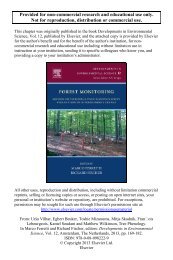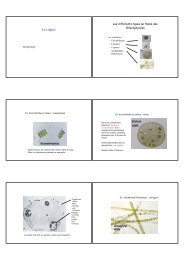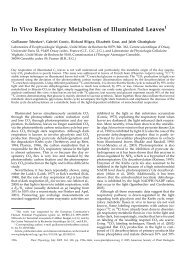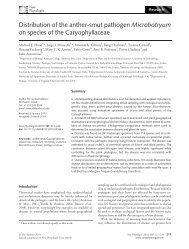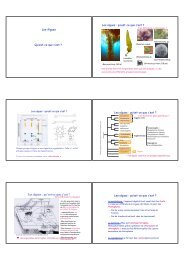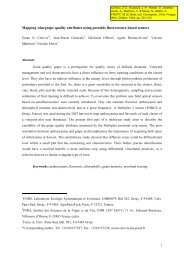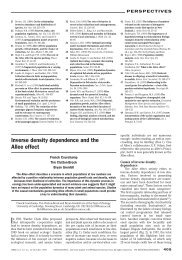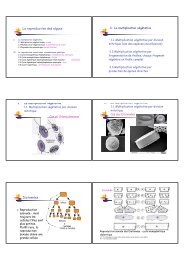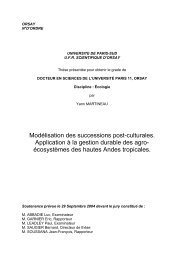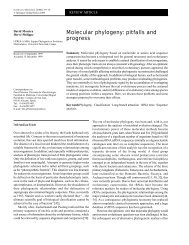Ancient Trans-specific Polymorphism at Pheromone Receptor ...
Ancient Trans-specific Polymorphism at Pheromone Receptor ...
Ancient Trans-specific Polymorphism at Pheromone Receptor ...
You also want an ePaper? Increase the reach of your titles
YUMPU automatically turns print PDFs into web optimized ePapers that Google loves.
Copyright Ó 2009 by the Genetics Society of AmericaDOI: 10.1534/genetics.108.093708<strong>Ancient</strong> <strong>Trans</strong>-<strong>specific</strong> <strong>Polymorphism</strong> <strong>at</strong> <strong>Pheromone</strong> <strong>Receptor</strong>Genes in BasidiomycetesBenjamin Devier,* ,1 Gabriela Aguileta,* ,1 Michael E. Hood † and T<strong>at</strong>iana Giraud* ,2*Ecologie, Systém<strong>at</strong>ique et Evolution, Centre N<strong>at</strong>ional de la Recherche Scientifique; Université Paris-Sud, F-91405 Orsay Cedex,France and † Department of Biology, McGuire Life Sciences Building, Amherst College, Amherst, Massachusetts 01002-5000Manuscript received July 8, 2008Accepted for public<strong>at</strong>ion November 5, 2008ABSTRACTIn the majority of sexual organisms, reproduction occurs almost exclusively through the combin<strong>at</strong>ion ofdistinct and altern<strong>at</strong>e forms, called sexes or m<strong>at</strong>ing types. In some fungi, there can be dozens to hundredsof altern<strong>at</strong>e alleles th<strong>at</strong> determine comp<strong>at</strong>ible m<strong>at</strong>ing types. Such extensive polymorphism is expected to bemaintained by balancing selection, and in extreme cases may give rise to trans-<strong>specific</strong> polymorphism. Here,we analyzed sequences of two pheromone receptors in the Microbotryum fungal species complex(Basidiomycota), which has only two altern<strong>at</strong>e m<strong>at</strong>ing types. Several lines of evidence strongly suggest th<strong>at</strong>the pheromone receptors are two allelic sequences acting to determine the altern<strong>at</strong>e A1 and A2 m<strong>at</strong>ing typesrequired for m<strong>at</strong>ing in Microbotryum. Phylogenetic trees of pheromone receptors in the Microbotryumspecies complex indic<strong>at</strong>ed a trans-<strong>specific</strong> polymorphism: the Microbotryum sequences from a given m<strong>at</strong>ingtype were all more similar to the pheromone receptors of distantly rel<strong>at</strong>ed classes of fungi than to thealtern<strong>at</strong>e pheromone receptor in the Microbotryum species. A phylogenetic tree built using other knownpheromone receptors from basidiomycetes showed th<strong>at</strong> trans-<strong>specific</strong> polymorphism is widespread. Thepheromone receptor alleles from Microbotryum appeared as the oldest, being <strong>at</strong> least 370 million years old.This represents the oldest known trans-<strong>specific</strong> polymorphism known in any organism so far, which may bedue to the existence of sex chromosomes, oblig<strong>at</strong>e sexuality, mitochondrial inheritance linked to the m<strong>at</strong>ingtype, and a highly selfing m<strong>at</strong>ing system in Microbotryum.INsexual organisms, reproduction occurs almostexclusively through the combin<strong>at</strong>ion of distinct andaltern<strong>at</strong>e forms, called sexes or m<strong>at</strong>ing types. Dimorphicsex chromosomes define m<strong>at</strong>ing comp<strong>at</strong>ibility in mostmammals, while more polymorphic systems, involvingdozens to hundreds of alleles, determine m<strong>at</strong>ing types insome plants and fungi (Richman 2000). Such extensivepolymorphism <strong>at</strong> m<strong>at</strong>ing types is maintained by neg<strong>at</strong>ivefrequency-dependent selection, the most common formof balancing selection (Richman 2000): when a m<strong>at</strong>ingtypeallele becomes rare, it has a selective advantagebecause the individuals carrying it can m<strong>at</strong>e with a largerproportion of other individuals. Balanced polymorphismof multiplealleles istherefore frequent <strong>at</strong> m<strong>at</strong>ing-typelociin a wide range of organisms, such as plants, insects, andfungi (May et al. 1999; Richman 2000), and it is alsopervasive in various som<strong>at</strong>ic self/nonself recognitionsystems, such as the vertebr<strong>at</strong>e major histocomp<strong>at</strong>ibilitycomplex (MHC) (Hughes and Yeager 1998) and theveget<strong>at</strong>ive incomp<strong>at</strong>ibility system in fungi (Powell et al.2007). Consistent with rare allele advantage, nonsynonymousmut<strong>at</strong>ionshavebeenfoundtobepositivelyselected1These authors contributed equally to this work.2Corresponding author: Ecologie, Systém<strong>at</strong>ique et Evolution, Bâtiment360, Université Paris-Sud, F-91405 Orsay Cedex, France.E-mail: t<strong>at</strong>iana.giraud@u-psud.frin several m<strong>at</strong>ing-type and nonself recognition systems(Richman 2000; Cho et al. 2006), including in fungi (Wuet al. 1998; Karlsson et al. 2008).In addition to potentially maintaining large numbersof alleles, genes under balancing selection also maintainalleles far longer than neutral genetic vari<strong>at</strong>ion becausethe selective advantage of an allele when it becomes rarecan counteract the effects of loss due to genetic drift. Inextreme cases, trans-<strong>specific</strong> polymorphism can be observed,i.e., the maintenance of multiple allelic classesth<strong>at</strong> transcend species boundaries by virtue of beingmore ancient than the species themselves (Richman2000). When this occurs, an allele sampled from aparticular species can be more rel<strong>at</strong>ed to members ofthe same functional allelic class in other species than tomembers of different allelic classes in the same species.Fungi are highly interesting models for studying theorigin and diversity of alleles by balancing and positiveselection, in particular <strong>at</strong> their m<strong>at</strong>ing-type genes. Inheterothallic fungi, m<strong>at</strong>ing-type loci determine sexualcomp<strong>at</strong>ibility: only gametes differing <strong>at</strong> these loci canm<strong>at</strong>e, and basidiomycetes often have high numbers ofm<strong>at</strong>ing types. However, very few studies have beendevoted to these aspects in fungi so far (but see Mayet al. 1999; Karlsson et al. 2008).M<strong>at</strong>ing-type loci have very different organiz<strong>at</strong>ions inthe two main groups of fungi. In ascomycetes, the twoGenetics 181: 209–223 ( January 2009)
210 B. Devier et al.altern<strong>at</strong>e m<strong>at</strong>ing types are ‘‘idiomorphs,’’ i.e.,nonhomologoussequences present <strong>at</strong> the same locus (Metzenbergand Glass 1990). These idiomorphs are completelydissimilar genes, with no evidence of deriv<strong>at</strong>ion by commondescent and encoding proteins with different functions.In Cochliobolus heterotrophus for instance, MAT1-1encodes an a-domain protein, while MAT1-2 encodes aHMG-domain protein (Stanton and Hull 2007).In contrast, m<strong>at</strong>ing comp<strong>at</strong>ibility in basidiomycetesoccurs between cells having different alleles <strong>at</strong> <strong>specific</strong>genes (e.g., Halsall et al. 2000; Kues 2000; Casseltonand Kues 2007). In the basidiomycete Ustilago maydisfor instance, a major fungal p<strong>at</strong>hogen of corn, cellrecognition, and fusion are regul<strong>at</strong>ed by a pheromone/receptor system th<strong>at</strong> resides <strong>at</strong> the a m<strong>at</strong>ing-type locus.All haploid cells have pheromone and receptor genes,and they can fuse only if they have different alleles <strong>at</strong>these genes. After fusion, maintenance of the dikaryonand the developmental switch to filamentous growthoccurs only if the product of m<strong>at</strong>ing is heterozygousfor the second b m<strong>at</strong>ing-type locus (Feldbrugge et al.2004). The b locus encodes homeodomain proteins th<strong>at</strong>function as transcriptional regul<strong>at</strong>ors. The majority ofsexual basidiomycete fungi possess a system similar toth<strong>at</strong> in U. maydis, called ‘‘tetrapolar,’’ where a and b lociare unlinked and haploids must have different allelesin both loci to m<strong>at</strong>e successfully. Other members ofthis phylum are ‘‘bipolar,’’ either because the a and bloci are tightly linked (e.g., inU. hordei, Bakkeren andKronstad 1994) or because only one of the loci hasa role in determining m<strong>at</strong>ing-type <strong>specific</strong>ity (e.g., inCoprinellus dissemin<strong>at</strong>us, James et al. 2006). The absenceof linkage between a and b loci in a tetrapolar system islikely the ancestral condition (Hibbett and Donoghue2001) and is often associ<strong>at</strong>ed with large numbers ofaltern<strong>at</strong>e alleles (Raper et al. 1960). In contrast, bipolarspecies are often biallelic, although not always ( Jameset al. 2006).In this study, we are interested in investig<strong>at</strong>ingwhether balancing selection and/or positive selectionare acting <strong>at</strong> m<strong>at</strong>ing-type genes in basidiomycete fungi.More <strong>specific</strong>ally, we will study the pheromone receptorgene (Figure 1). In U. maydis, each haploid cell containsboth a pheromone gene and a pheromone receptorgene <strong>at</strong> the a locus. Only cells having different alleles<strong>at</strong> these genes can m<strong>at</strong>e (Figure 1A). Only the pheromonefrom one allele can activ<strong>at</strong>e the receptor ofthe altern<strong>at</strong>ive allele. Recombin<strong>at</strong>ion is suppressed betweenthe pheromone and receptor genes, avoiding theemergence of self-comp<strong>at</strong>ible haploids, as the two genesare separ<strong>at</strong>ed by a region unique to each m<strong>at</strong>ing type.Mushroom forming homobasidiomycetes (e.g., Coprinopsiscinerea) have evolved multiple versions of theirpheromones and receptors (Figure 1B) (Casseltonand Kues 2007). The B locus in these fungi (homologousto the a locus of Ustilago species) contains severalsubloci, with different paralogs of the pheromone and ofFigure 1.—Organiz<strong>at</strong>ion of the locus encompassing thepheromone (narrow vertical rectangles) and pheromone receptor(wide horizontal rectangles) genes in Ustilago maydis (A) andCoprinopsis cinerea (B). Arrows indic<strong>at</strong>e receptor and pheromonecombin<strong>at</strong>ions th<strong>at</strong> are comp<strong>at</strong>ible. Different degrees of shading(solid, shaded, open) indic<strong>at</strong>e paralogs and different filled motifsindic<strong>at</strong>e alleles. The a locus in U. maydis has one a-receptorgene (pra) and one a-pheromone gene (mfra). The productsof Iga2 and Rga2 (squares) have no obvious role in sexual developmentbut are involved in mitochondrial function (Bortfeldet al. 2004). The B locus of C. cinerea is composed of three subloci,each containing a receptor gene and two pheromone genes. Fortwo haploid cells to be comp<strong>at</strong>ible, it is required and sufficientth<strong>at</strong> they have different alleles for <strong>at</strong> least one of the sublocus.<strong>Pheromone</strong>s can only activ<strong>at</strong>e receptors within the same sublocusclass. This figure has been adapted from Casselton andKues (2007) and Stanton and Hull (2007).the pheromone receptor genes. For two haploid cellsto be comp<strong>at</strong>ible, it is required and sufficient th<strong>at</strong> theyhave different alleles for <strong>at</strong> least one of the subloci.<strong>Pheromone</strong>s can only activ<strong>at</strong>e receptors within the samesublocus class in C. cinerea (Casselton and Kues 2007).The genes within each sublocus are maintained as afunctional unit by being separ<strong>at</strong>ed by a unique DNAsequence th<strong>at</strong> is very dissimilar from other allelic andparalogous versions (Casselton and Kues 2007). Thislack of DNA homology extends into the flankingregions, which prevents recombin<strong>at</strong>ion and keeps togethersets of genes so th<strong>at</strong> sexual development is impossiblein the absence of m<strong>at</strong>ing. These highlydissimilar flanking regions in basidiomycetes could besuggestive of the idiomorphs in ascomycetes. However,in contrast to ascomycetes, homologs can be easilyrecognized in the core m<strong>at</strong>ing-type genes themselves, inparticular in the pheromone receptor genes (Casseltonand Kues 2007) (Figure 1). Alleles can therefore bedefined for pheromone receptor genes and this term iscommonly used for the m<strong>at</strong>ing-type genes in basidiomycetes(e.g., Casselton and Kues 2007). This is true inparticular for all basidiomycetes th<strong>at</strong> are basal to thehomobasidiomycetes, which have a single copy of thepheromone receptor gene.
<strong>Trans</strong>-<strong>specific</strong> <strong>Polymorphism</strong> in Fungi 211The region with suppressed recombin<strong>at</strong>ion aroundthe core m<strong>at</strong>ing-type genes can extend very far and encompassother genes. M<strong>at</strong>ing-type loci in some fungi areindeed found in chromosomal regions th<strong>at</strong>, in severalcases, present clear parallels to sex chromosomes characterizedin plant and animal systems (Hood et al.2004; Fraser and Heitman 2005; Menkis et al. 2008).An example of incipient sex chromosomes is found inthe basidiomycete Cryptococcus neoformans, a ubiquitoushuman fungal p<strong>at</strong>hogen with a bipolar m<strong>at</strong>ing-typesystem: recombin<strong>at</strong>ion suppression around the corem<strong>at</strong>ing-type genes include .20 genes and extends .100kbp in length (Fraser et al. 2004). An even more extremeexample is Microbotryum violaceum, which is alsobipolar and possesses true-size dimorphic sex chromosomes,with suppressed recombin<strong>at</strong>ion throughoutmuch of their lengths (Hood 2002; Hood et al. 2004;Hood and Antonovics 2004).M. violaceum causes a sexually transmitted disease,anther smut, in plants of the Caryophyllaceae family(Thrall et al. 1993). Diploid teliospores of the fungusare produced in the anthers of infected plants, replacingthe pollen, and female structures are aborted.Deposited by pollin<strong>at</strong>ors on a new host, teliospores germin<strong>at</strong>e,and the fungus then undergoes meiosis. Sexualconjug<strong>at</strong>ion between two haploid cells of the twoopposite m<strong>at</strong>ing types (A1 and A2) is required priorto infection, selfing being predominant (Hood andAntonovics 2000; Giraud 2004; Giraud et al. 2005,2008). Conjug<strong>at</strong>ion, and thus cell fusion, is initi<strong>at</strong>edonly between sporidia of different m<strong>at</strong>ing types (Garberand Rudd<strong>at</strong> 2002), indic<strong>at</strong>ing th<strong>at</strong> pheromones andpheromone receptors are involved in this process, as inUstilago species (Feldbrugge et al. 2004). M. violaceumis a complex of sibling species, specialized on differenthosts and showing postzygotic isol<strong>at</strong>ion, but the taxonomyhas not been fully revised yet (Kemler et al. 2006;Le Gac et al. 2007a,b; Sloan et al. 2008). Size-dimorphicsex chromosomes are present in multiple Microbotryumspecies, exhibiting large-scale recombin<strong>at</strong>ionsuppression and high levels of allelic and structuralheterozygosity (Hood 2002; Hood and Antonovics2004). Two put<strong>at</strong>ive STE3-like pheromone receptorshave recently been characterized among sequencesexpressed during m<strong>at</strong>ing in the Microbotryum speciesinfecting Silene l<strong>at</strong>ifolia (Yockteng et al. 2007). Theywere respectively associ<strong>at</strong>ed with A1 and A2 m<strong>at</strong>ingbehavior of haploid sporidia, thus probably constitutingaltern<strong>at</strong>ive alleles of the homolog for the pheromonereceptor <strong>at</strong> the a locus in U. maydis, although theirfunction has not been experimentally demonstr<strong>at</strong>edyet.Here we analyzed the sequences of the two characterizedpheromone receptors, pr-M<strong>at</strong>A1 and pr-M<strong>at</strong>A2,in multiple Microbotryum species to investig<strong>at</strong>e theirevolution. In particular, our aims were: (1) to obtainmore inform<strong>at</strong>ion on the put<strong>at</strong>ive allelic st<strong>at</strong>us of thetwo sequences of pheromone receptors characterized inMicrobotryum; (2) to look for footprints of positiveselection among Microbotryum species, which mightoccur for instance if the pheromone receptor is involvedin species recognition during m<strong>at</strong>ing or if there isregular selection for novel m<strong>at</strong>ing-type <strong>specific</strong>ities; (3)to look for footprints of balancing selection and trans<strong>specific</strong>polymorphism <strong>at</strong> the pheromone receptorgenes in Microbotryum; trans-<strong>specific</strong> polymorphismwill be detected if alleles of a given species are notmonophyletic, as is usually the case, but r<strong>at</strong>her are closerto alleles from other species than to altern<strong>at</strong>e allelesfrom their own species; and (4) to compare the Microbotryumpheromone receptors with those of otherfungi to gain more general insight into the evolutionof fungal m<strong>at</strong>ing types, in particular to assess whetherbalancing selection and trans-<strong>specific</strong> polymorphismcould be detected more generally in basidiomycetes.MATERIALS AND METHODSFungal isol<strong>at</strong>es, DNA extraction, PCR, and sequencing: ForDNA sequencing, we used 38 Microbotryum strains, belongingto <strong>at</strong> least 13 different fungal species (Le Gac et al. 2007a),collected from 18 host species in western Europe and America(Table 1). Species have been recognized on the basis of congruencebetween multiple phylogenies and await full taxonomicrevision. Diploid teliospores were stored and grown aspreviously described (Le Gac et al. 2007a). Single sporidialcolonies, representing haploid clonal colonies derived froma single meiotic product, were isol<strong>at</strong>ed and cultured for DNAextraction as previously described (Le Gac et al. 2007a). Foreach diploid sample (teliospores in flowers), necessarily heterozygous<strong>at</strong> the m<strong>at</strong>ing-type locus, we thus obtained bothcolonies of A1 haploid sporidia and colonies of A2 haploidsporidia. The m<strong>at</strong>ing type of sporidia was determined bycrossing them in vitro against stock sporidia of known m<strong>at</strong>ingtype, as previously described (Thomas et al. 2003). DNA wasextracted using the Chelex (Bio-Rad) protocol (Giraud2004).Most of the length of the two put<strong>at</strong>ive pheromone receptors,pr-M<strong>at</strong>A1 and pr-M<strong>at</strong>A2 (Figure 2), was amplified andsequenced, using the primers given in Table 2 and TouchdownPCR programs with annealing temper<strong>at</strong>ures from 60° down to45°. PCR products were purified and sequenced in bothdirections as previously described (Le Gac et al. 2007a). Thesequences are available in GenBank (accession nos: FJ200750–FJ200809).The eight primer pairs in Table 2 were also used for PCR <strong>at</strong>low annealing temper<strong>at</strong>ure to detect other put<strong>at</strong>ive pheromonereceptors in DNA extracted from the stock sporidia ofknown m<strong>at</strong>ing types for the Microbotryum species MvSl. Theeight primer pairs were used with a PCR program having anannealing temper<strong>at</strong>ure of 48° and using three replic<strong>at</strong>e DNAextractions from each of A1 and A2 m<strong>at</strong>ing-type sporidia. PCRproducts were then run on agarose gels. For band isol<strong>at</strong>ion onagarose gels, the QIAEX2 gel extraction kit from QIAGEN wasused.Positive selection: We wanted to investig<strong>at</strong>e whether positiveDarwinian selection had influence in the evolution of eachof the A1 and A2 pheromone receptors in the Microbotryumspecies complex. We analyzed pr-M<strong>at</strong>A1 and pr-M<strong>at</strong>A2 separ<strong>at</strong>ely,testing for positive selection across the sites of eachnucleotide (codon) alignment. Positive selection was tested
212 B. Devier et al.TABLE 1Characteristics of the Microbotryum isol<strong>at</strong>es used in this studyHost species Isol<strong>at</strong>e name Geographical originObtained sequencesD<strong>at</strong>e ofcollection pr-M<strong>at</strong>A1 pr-M<strong>at</strong>A2Microbotryum speciesLe Gac et al.(2007a)Kemleret al. (2006);Denchev (2007)Dianthus carthusianorum 2002 Site 23 Sestrière, Italy 2002 X MvDsp1 M. dianthorumD. carthusianorum DC70.42 The Alps, Switzerland 2001 X X MvDsp1 M. dianthorumD. carthusianorum 70.22 The Alps, Switzerland 2001 X MvDsp1 M. dianthorumD. carthusianorum 433.09 Disentis, Switzerland 2006 X X MvDc M. dianthorumD. neglectus 19 The Alps, France 2004 X MvDsp2 M. dianthorumD. neglectus IT03 St. Anna (Site 8) Saint Anna, Italy 2003 X MvDsp2 M. dianthorumD. sylvestris IT02 19-2A The Alps, Italy 2002 X X MvDsp1 M. dianthorumGypsophila repens GR4 Grosio, Italy NC X MvDc M. dianthorumLychnis flos cuculi 92.04 The Alps, Switzerland 2001 X X MvLf M. silenes-infl<strong>at</strong>aeL. flos cuculi 92.05 The Alps, Switzerland 2001 X MvLf M. silenes-infl<strong>at</strong>aeL. flos-cuculi L.fc fGS12 Sheffield, United Kingdom NC X X MvLf M. silenes-infl<strong>at</strong>aeL. flos-jovis IT03 ValDePesio Site 5 Sporidia E (A2) Valle de Pesio, Italy 2003 X MvLfjSaponaria ocymoides 02 Site21 Tet1 Sestrière, Italy 2002 X X MvSoff M. saponariaeS. ocymoides IT03 Sta1 Plant 2 Saint Anna, Italy 2003 X X MvSoff M. saponariaeS. ocymoides IT02 19-1 Cesana Torinese, Italy 2002 XS. officinalis 441 Sazos, French Pyrénées 2006 X X MvSoff M. saponariaeSilene acaulis FR02 Site 5 Gare de Peyrou d’Amont, France 2002 X MvSa M. violaceumS. acaulis 89.01 The Alps, Switzerland 2001 X X MvSa M. violaceumS. acaulis 2002 Site 26 D A1 Sestrière, Italy 2002 X X MvSa M. violaceumS. caroliniana 384 Blue Ridge Parkway, USA NC X MvSspA M. violaceumS. dioica 01 Site Charterhouse, United Kingdom 2001 X X MvSd M. lychnidis-dioicaeS. l<strong>at</strong>ifolia 41.06 Essonne, France 2001 X X MvSl M. lychnidis-dioicaeS. l<strong>at</strong>ifolia 100.06 The Alps, Switzerland 2001 X X MvSl M. lychnidis-dioicaeS. l<strong>at</strong>ifolia UK00 Aldeburgh 14-1 Aldeburgh, United Kingdom 2000 X X MvSl M. lychnidis-dioicaeS. l<strong>at</strong>ifolia UK00 5.1H.9 United Kingdom 2000 X X MvSl M. lychnidis-dioicaeS. l<strong>at</strong>ifolia IT01 Lamole Site 15Plant 1 Lamole, Italy 2001 X X MvSl M. lychnidis-dioicaeS. maritima UK02 Charter House 1-2 (liz) C (A1) Charterhouse, United Kingdom 2002 X X MvSv1 M. silenes-infl<strong>at</strong>aeS. maritima 365 Grunda, Olafsvik, Iceland 2005 X MvSv2 M. silenes-infl<strong>at</strong>aeS. nutans IT03 Guarda 1 Guarda, Switzerland 2003 X X MvSn M. violaceumS. nutans 70.01 The Alps, Switzerland 2001 X MvSn M. violaceumS. paradoxa IT04-2 Lamole, Italy 2004 XAtocion rupestris 02 Site 46- Chambéry, France 2002 X X MvSv1 M. lagerheimiiS. virginica 387 Charlottesville Reservoir, Virginia, USA NC X MvSspA M. violaceumS. vulgaris FR02 Site 44-1 Chambéry, France 2002 X X MvSv1 M. lagerheimiiS. vulgaris S.v.Sestri IT03 Sestrière, Italy 2003 X X MvSv2 M. silenes-infl<strong>at</strong>aeS. vulgaris 300.28 French Pyrénées, pic du midi de bigorre 2003 X MvSv1 M. lagerheimiiS. vulgaris 84.19 The Alps, Switzerland 2001 X MvSv2 M. silenes-infl<strong>at</strong>aeS. vulgaris 300.26 French Pyrénées, pic du midi de bigorre 2003 X MvSv2 M. silenes-infl<strong>at</strong>aeHost species, isol<strong>at</strong>e name, geographical origin, d<strong>at</strong>e of collection, obtained sequences (pr-M<strong>at</strong>A1 and/or pr-M<strong>at</strong>A2), and name of the Microbotryum species based onprevious studies are shown.
<strong>Trans</strong>-<strong>specific</strong> <strong>Polymorphism</strong> in Fungi 213Figure 2.—Illustr<strong>at</strong>ion of the fragments of thepheromone receptors pr-M<strong>at</strong>A1 and pr-M<strong>at</strong>A2th<strong>at</strong> were sequenced in multiple Microbotryumspecies. Two overlapping fragments were amplifiedper receptor using the primers indic<strong>at</strong>edin Table 2.for with the CODEML program of the PAML package (Yang1997). Selective pressure was measured by using the nonsynonymous(d N )/synonymous (d S ) substitution r<strong>at</strong>e r<strong>at</strong>io v.An v , 1 suggests purifying selection, v ¼ 1 is consistent withneutral evolution, and v . 1 is indic<strong>at</strong>ive of positive selection(Yang and Bielawski 2000). Nested codon models implementingthe v r<strong>at</strong>io can be compared by means of a likelihoodr<strong>at</strong>io test (LRT) (Anisimova et al. 2001). We used the nullmodel M1a, which assumes two site classes with 1 . v 0 . 0, andv 1 ¼ 1, which therefore assumes no sites under positiveselection, and compared it with the altern<strong>at</strong>ive model M2a,which adds an extra class of sites th<strong>at</strong> allows v to take values.1. We also compared the null model M7, which assumes abeta distribution of v across sites, with the altern<strong>at</strong>ive modelM8, which adds an extra class of sites to M7 where v can takevalues .1. Thereby positive selection can be detected if amodel allowing for positive selection is significantly morelikely (as estim<strong>at</strong>ed by the LRT) than a null model withoutpositive selection.Phylogenetic trees for investig<strong>at</strong>ing trans-<strong>specific</strong> polymorphism:As the nucleotides sequences of pr-M<strong>at</strong>A1 andpr-M<strong>at</strong>A2 were too divergent to be reliably aligned, phylogenetictrees were built using amino acid sequences. Sequencesfrom other fungi available in GenBank were also included tohave the appropri<strong>at</strong>e sampling scope for investig<strong>at</strong>ing trans<strong>specific</strong>polymorphism. All sequences were aligned and assembledusing Bioedit v6.0.7 and were manually edited whennecessary. We kept only the alignment sections th<strong>at</strong> wereunambiguously aligned and without gaps. Phylogenetic treeswere reconstructed by neighbor joining (NJ) and maximumlikelihood (ML).We first built a NJ tree including all the Microbotryumsequences (Figure 3) obtained by sequencing 1200 bp of pr-M<strong>at</strong>A1 and 1000 bp of pr-M<strong>at</strong>A2 (Figure 2 and Table 1). Forthe sake of clarity, we added here only the first GenBank hitsfor both pr-M<strong>at</strong>A1 and pr-M<strong>at</strong>A2 (Figure 3). The NJ tree wasobtained using the Protdist and Neighbor programs in thePhylip package (Felsenstein 1989). Distances were derivedassuming the JTT 1 G model (Jones et al. 1992), a commonlyused probabilistic amino acid replacement m<strong>at</strong>rix <strong>at</strong> the 85%identity level, and allowing for r<strong>at</strong>e heterogeneity among sites.The Seqboot program in the PHYLIP package was used toproduce 100 resampled d<strong>at</strong>a sets, and bootstrap supportproportions were obtained using the Consense program inTABLE 2Characteristics of the primers used in this studyPrimer name Sequence Tm (°) <strong>Receptor</strong> Amplified partContig2096F TCCTTTGTCACGACAAGCAC 52 pr-M<strong>at</strong> A1 59 partContig660R CTGCGTCACGATACCTTTCTT 52 pr-M<strong>at</strong> A1 59 partContig2096F2 a ATAGTGCACGTCTGCCCAAC 62 pr-M<strong>at</strong> A1 59 partContig660R2 a GTGTGGCATTGGCGAGTC 58 pr-M<strong>at</strong> A1 59 partpr0aab52-F ATGACTCAGGCATCACCATC 60 pr-M<strong>at</strong> A1 39 partpr0aab52-R TTGAAGGCGCTCTTCTATTACA 52 pr-M<strong>at</strong> A1 39 partpr0aab52-F2 a TACCAATTTTCGCGCCTACT 58 pr-M<strong>at</strong> A1 39 partpr0aab52-R2 a CCGACTGGGACGCTTCTT 58 pr-M<strong>at</strong> A1 39 part1578-GCHE-F TCTTCACTTCGCGATACCAA 58 pr-M<strong>at</strong> A2 59 part1578-GCHE-R GCCATATCCCTTCACAATGG 60 pr-M<strong>at</strong> A2 59 part1578-GCHE-F2 a GCGATACCAAGACACGATCA 60 pr-M<strong>at</strong> A2 59 part1578-GCHE-R2 a CACAATGGCAAACCTTGTTG 58 pr-M<strong>at</strong> A2 59 part1578-DTE-F GAATAGGTGCCGAGATAGGG 62 pr-M<strong>at</strong> A2 39 part1578-DTE-R TCAAGATAACGACCTGTGATGC 52 pr-M<strong>at</strong> A2 39 part1578-DTE-F2 a TTTCTGTGTTGCACGCTTTC 58 pr-M<strong>at</strong> A2 39 part1578-DTE-R2 a TCAGATCGATGATAGTCCCGTA 51 pr-M<strong>at</strong> A2 39 partName, sequence, annealing temper<strong>at</strong>ure (Tm), corresponding pheromone receptor (pr-M<strong>at</strong>A1 or pr-M<strong>at</strong>A2), and amplified part of the pheromone receptor (see also Figure 1) are shown. Two pairs of primerswere used per pheromone receptor, amplifying overlapping fragments (respectively, 59 and 39 parts).aFor these contigs, altern<strong>at</strong>ive primer pairs were designed when amplific<strong>at</strong>ion failed.
214 B. Devier et al.Figure 3.—Phylogeny based on the aminoacid sequences of parts of the pheromone receptorspr-M<strong>at</strong>A1 and pr-M<strong>at</strong>A2 of Microbotryumand other fungi. Nodes not strongly supportedare represented as unresolved. St<strong>at</strong>istical supportsindic<strong>at</strong>e NJ bootstraps. Taxa labels forMicrobotryum sequences correspond to the m<strong>at</strong>ingtype (A1 or A2) and to the host plant onwhich fungal strains were collected.the PHYLIP package, assuming the majority rule criterion toderive the consensus tree (Felsenstein 1989). We corrobor<strong>at</strong>edthe NJ tree by constructing an ML tree with the samesequences using TreeFinder version May 2007 ( Jobb 2007).The ModelTest v3.5 program (Posada and Crandall 1998)with Akaike inform<strong>at</strong>ion criterion (AIC) was used to select themodels th<strong>at</strong> best fit our d<strong>at</strong>a. The PMB (probability m<strong>at</strong>rixfrom Blocks) model of sequence evolution was assumed,which uses the Blocks d<strong>at</strong>abase of protein alignments alongwith the additivity of evolutionary distances, to approxim<strong>at</strong>ethe amino acid substitution probabilities as a function ofactual evolutionary distance (Veerassamy et al. 2003).We then built a second tree by ML using other characterizedcomplete STE3-like pheromone receptors from basidiomycetes,including the two from Microbotryum (Figure 4). Accessionnumbers are as follows: M. violaceum pr-M<strong>at</strong>A2 (EF584741) andpr-M<strong>at</strong>A1 (EF584742); C. cinerea RCB1.3 (AAO17255), RCB1.6(CAA71964), RCB2.6 (CAA71963), RCB2.42 (AAF01419),RCB2.43 (AAQ96345), RCB2.44 (AAQ96344), RCB3.6(CAA71962), and RCB3.42 (AAF01420); Schizophyllum communeBAR1 (Q92275), BAR2 (CAA62595), BAR3 (P56502), BAR8(AAR99618), BBR1 (P78741), and BBR2 (AAD35087); Pleurotusdjamor PDSTE3.3 (AAS46748), PDSTE3.2 (AAP57506), andPDSTE3.1 (AAP57502); C. neoformans CPRa (AAF71292) andSTE3a (AAN75156); C. g<strong>at</strong>ti STE3p (AAV28793); U. maydis PRA1(P31302) and PRA2 (P31303); U. hordei PRA1 (Q99063) andPRA2 (AAD56044); Pneumocystis carinii (AAG38536); Saccharomycescerevisiae (P06783); Sporisorium reilianum pheromonereceptors a1 (CAI59749), a2 (CAI59755), and a3 (CAI59763);Puccinia graminis hypothetical protein (PGTG_195592.2), conservedhypothetical protein (PGTG_00333.2), hypotheticalprotein similar to B beta m<strong>at</strong>ing-type pheromone receptor(PGTG_01392.2); C. dissemin<strong>at</strong>us put<strong>at</strong>ive pheromone receptorsCDSTE3.1 (AAP57492), CDSTE3.2 (AAZ04776), CDSTE3.3(AAZ14943), and CDSTE3.4 (AAY88882). For P. graminis, weused the three proteins th<strong>at</strong> yielded a significant hit when thepheromone receptors of M. violaceum were blasted againstthecompletegenome(http://www.broad.mit.edu/annot<strong>at</strong>ion/genome/puccinia_graminis), although a single one was annot<strong>at</strong>edas ‘‘pheromone receptor.’’ The trees based on theresulting 297-amino-acid alignment were rooted using thesequences from the ascomycetes P. carinii and S. cerevisiae. Tobuild this phylogenetic tree under a maximum likelihoodframework we used the program PHYML (Guindon andGascuel 2003). We assumed the protein model WAG 1 G 1 I(Whelan and Goldman 2001), which unlike the JTT model
<strong>Trans</strong>-<strong>specific</strong> <strong>Polymorphism</strong> in Fungi 215Figure 4.—Phylogeny of all known complete STE3-like pheromone receptors from basidiomycete fungi, obtained from thePHYML analysis. St<strong>at</strong>istical supports indic<strong>at</strong>e ML bootstraps. The calibr<strong>at</strong>ion point of 450 MY is indic<strong>at</strong>ed (node A), as well asthe d<strong>at</strong>es for nodes B and C inferred from the molecular clock analysis, whose resulting phylogeny is shown in supplementalFigure S3. The phylogeny of the same genera based on nuclear gene sequences obtained in previous works (Roux et al. 1998;Lutzoni et al. 2004; Blackwell et al. 2006; James et al. 2006; Garnica et al. 2007; James 2007; M<strong>at</strong>heny et al. 2007) is givenas an inset. The calibr<strong>at</strong>ion point of 450 MY, which represents the divergence between ascomycetes and basidiomycetes, is alsoindic<strong>at</strong>ed, as well as the duplic<strong>at</strong>ion of pheromone receptor genes <strong>at</strong> the m<strong>at</strong>ing-type locus. The time calibr<strong>at</strong>ion was determinedusing a molecular clock analysis performed with PAML (supplemental Figure S3) and was placed on the PHYML tree for convenience.employs an approxim<strong>at</strong>e maximum-likelihood method toestim<strong>at</strong>e amino acid replacement m<strong>at</strong>rices on the basis of alarge sample of protein families. We allowed for among-siter<strong>at</strong>e vari<strong>at</strong>ion by using the discrete gamma model with four r<strong>at</strong>eclasses, and we estim<strong>at</strong>ed and optimized the proportion ofinvariable sites. The bootstrap analysis was done directly withPHYML, with which we gener<strong>at</strong>ed 100 d<strong>at</strong>a set replic<strong>at</strong>es andestim<strong>at</strong>ed a tree for each. The consensus tree was obtained bythe majority rule criterion using the program Consense in thePHYLIP package (Felsenstein 1989).To verify the placement of pr-M<strong>at</strong>A1 and pr-M<strong>at</strong>A2 in theML tree inferred for the STE3-like pheromone receptorsin basidiomycetes, we conducted different phylogenetic testscomparing three topologies: (i) the tree previously obtained(Figure 4), (ii) an enforced topology placing the pr-M<strong>at</strong>A1 asbranching on the same lineage as pr-M<strong>at</strong>A2, either <strong>at</strong> its baseor as a sister leaf (supplemental Figure S1, A and B), and (iii)an enforced topology placing pr-M<strong>at</strong>A2 as branching on thesame lineage as pr-M<strong>at</strong>A1, either <strong>at</strong> its base or as a sister leaf(supplemental Figure S2, A and B). Other than the displacementof either pr-M<strong>at</strong>A1 or pr-M<strong>at</strong>A2 in the two respectiveenforced phylogenies, the trees under comparison have thesame topology. The topologies were compared using theCONSEL v0.1i software (Shimodaira and Hasegawa 2001),which implements the AU test (Shimodaira and Hasegawa2001), the KH test (Kishino and Hasegawa 1989), the SH test(Shimodaira and Hasegawa 1999), and the RELL bootstrapproportions (Shimodaira and Hasegawa 1999). These testscompare the P-value associ<strong>at</strong>ed with each tree, which representsthe possibility of th<strong>at</strong> tree being the true tree. We couldthus rank the competing topologies according to their P-valuesto determine the most likely topology.Inference of allele age: To infer the age of the divergencebetween alleles, we used the CODEML program in the PAMLpackage (Yang 1997), which employs maximum likelihood toestim<strong>at</strong>e node d<strong>at</strong>es. Under the molecular clock assumption,
216 B. Devier et al.the distance between sequences increases linearly with theirtime of divergence, and by using an external point ofreference (e.g., a fossil record) the clock can be calibr<strong>at</strong>ed toestim<strong>at</strong>e sequence distances and then infer the associ<strong>at</strong>edd<strong>at</strong>es. CODEML allows the use of multiple calibr<strong>at</strong>ion points,confidence intervals around these points, as well as therelax<strong>at</strong>ion of the clock assumption. However, given the sparsegeologic fossil record available for fungi, we used the onlyreliable calibr<strong>at</strong>ion point available for our d<strong>at</strong>a set and fixed itto calibr<strong>at</strong>e the clock. We used the Global Clock methodassuming the WAG model for node d<strong>at</strong>e estim<strong>at</strong>ion, instead ofthe multiple local clock option th<strong>at</strong> would be preferred hadwe more available fossil estim<strong>at</strong>es for the phylogenetic scopeof the present study. A recent study used different fossils ascalibr<strong>at</strong>ion points (Taylor and Berbee 2006) and estim<strong>at</strong>ed aminimal age of 330 MY for the divergence between Cryptococcusand Coprinopsis on the one hand, and Ustilago andPuccinia on the other hand. However, the placement ofPuccinia in the same clade with Ustilago is not supported inall published phylogenies; instead, within the basidiomycetesPuccinia species are often more basal than Coprinus andUstilago (Lutzoni et al. 2004; James et al. 2006; Aguileta et al.2008). We did not use the divergence between Cryptococcusand Coprinopsis as a calibr<strong>at</strong>ion point because of the presenceof paralogs <strong>at</strong> pheromone receptor genes in these species. Wetherefore chose to use the divergence between ascomycetesand basidiomycetes, estim<strong>at</strong>ed between 450 and 1500 MY(Taylor and Berbee 2006), as a fixed calibr<strong>at</strong>ion point. Theminimal age of node A on Figure 4 was fixed according to thelower estim<strong>at</strong>e, i.e., 450 MY.RESULTSAllelic st<strong>at</strong>us of the two pheromone receptorsidentified in Microbotryum: The two pheromone receptorsequences characterized in Microbotryum arestrictly associ<strong>at</strong>ed with the m<strong>at</strong>ing behavior (A1 or A2)of sporidia (Yocktenget al. 2007). The most straightforwardhypothesis is th<strong>at</strong> they constitute alleles <strong>at</strong> thepheromone receptor gene involved in the determin<strong>at</strong>ionof the A1 vs. A2 m<strong>at</strong>ing types. They should then bethe sole pheromone receptor sequences expressed duringm<strong>at</strong>ing. They could altern<strong>at</strong>ively be linked paralogswith somehow different functions in the m<strong>at</strong>ing process,although such a case has never been reported in basidiomycetes.In this l<strong>at</strong>ter case, altern<strong>at</strong>ive alleles of each ofthe two characterized sequences, pr-M<strong>at</strong>A1 and pr-M<strong>at</strong>A2, should exist. The altern<strong>at</strong>ive allele of pr-M<strong>at</strong>A1should then be found in A2 sporidia, the altern<strong>at</strong>ive alleleof pr-M<strong>at</strong>A2 should be found in A1 sporidia, and <strong>at</strong> leastfour sequences of pheromone receptors should be expressedduring m<strong>at</strong>ing.To look for these hypothetical altern<strong>at</strong>ive alleles, wefirst performed PCRs using four primer pairs designedon each of pr-M<strong>at</strong>A1 and pr-M<strong>at</strong>A2 (Table 2) <strong>at</strong> lowannealing temper<strong>at</strong>ure (48°), on each of two stock A1and A2 sporidia. Primer pairs designed on pr-M<strong>at</strong>A2never amplified any band in any A1 sporidia. Theproaab52 primer pair designed on pr-M<strong>at</strong>A1 did notamplify any band in any A2 sporidia. The contig-2096primer pair designed on pr-M<strong>at</strong>A1 amplified a band inA2 sporidia, <strong>at</strong> a smaller size than the expected band inA1 sporidia. This smaller band was also present in A1sporidia, in addition to the band of expected size. Wesequenced this PCR product after isol<strong>at</strong>ion on gel, butthis second band did not correspond to pheromonereceptors. We therefore could not amplify in A1 sporidiaany sequence similar to pr-M<strong>at</strong>A2, and vice versa.To further investig<strong>at</strong>e the existence of possiblealtern<strong>at</strong>ive alleles of pr-M<strong>at</strong>A2 and pr-M<strong>at</strong>A1, we lookedfor other pheromone receptor sequences in the fourcDNA libraries built on each of four Microbotryumspecies during m<strong>at</strong>ing, from which 40,000 clones havebeen sequenced by the Genoscope (Yockteng et al.2007; and our unpublished d<strong>at</strong>a). These libraries representexcellent coverage of the expressed genes ofMicrobotryum, yielding between 5000 and 7000 unisequenceseach (Yockteng et al. 2007); and our unpublishedd<strong>at</strong>a). The unisequences are all contigs andsinglets, the contigs being assembled ESTs and thesinglets being ESTs th<strong>at</strong> cannot be assembled with otherESTs. The libraries were built using conjug<strong>at</strong>ing sporidia,i.e., the stage <strong>at</strong> which the function of pheromonereceptors is required, and in fact pr-M<strong>at</strong>A1 and pr-M<strong>at</strong>A2were first identified among the ESTs of the library on S.l<strong>at</strong>ifolia (Yockteng et al. 2007). We performed BLASTnand tBLASTx searches using pr-M<strong>at</strong>A1 and pr-M<strong>at</strong>A2 asqueries on the four cDNA libraries (Table 3). SeveralESTs gave significant blast scores against each of pr-M<strong>at</strong>A1 and pr-M<strong>at</strong>A2, showing again good coverage ofour libraries, especially those on the Microbotryumspecies from S. l<strong>at</strong>ifolia and Dianthus carthusianorum.BLASTn searches hit only sequences with 99% similaritywith the queries, i.e., only with exactly the sametranscript. The tBLASTx searches hit EST sequenceswith 99% similarities to the queries but hit also theknown altern<strong>at</strong>ive pheromone receptor with lower similarity,as expected because the tBLASTx program alignsprotein sequences (Table 3). The tBLASTx searcheswere therefore able to retrieve distant pheromone receptors,but they hit only sequences with 99% similaritywith either pr-M<strong>at</strong>A1 or pr-M<strong>at</strong>A2, but not othersequences. This strongly suggests th<strong>at</strong> no other pheromonereceptors are expressed in Microbotryum duringm<strong>at</strong>ing, apart from the previously characterized pr-M<strong>at</strong>A1 and pr-M<strong>at</strong>A2 receptors.Lack of positive selection <strong>at</strong> Microbotryum pheromonereceptors: Comparison among 38 Microbotryumstrains revealed sequence variability <strong>at</strong> 14.72% of nucleotidepositions among pr-M<strong>at</strong>A1 sequences and <strong>at</strong>33.07% of sites in sequences of pr-M<strong>at</strong>A2. The somewh<strong>at</strong>higher variability among pr-M<strong>at</strong>A1 was due to the presenceof sequences from a Microbotryum species distantfrom the other ones (from the host plant S. paradoxa),which was not sequenced for pr-M<strong>at</strong>A2.The A1 sequences on the one hand and the A2sequences on the other hand were compared amongMicrobotryum species. No evidence of positive selectionwas detected <strong>at</strong> any site in either pheromone receptor,
<strong>Trans</strong>-<strong>specific</strong> <strong>Polymorphism</strong> in Fungi 217TABLE 3Results from Blast searches on the four cDNA libraries of Microbotryum using the pheromone receptors pr-M<strong>at</strong>A1 and pr-M<strong>at</strong>A2as queriesBlast with pr-M<strong>at</strong>A1Blast with pr-M<strong>at</strong>A2Blastn tblastx Blastn tblastxcDNA library of Microbotryum from Silene l<strong>at</strong>ifoliaContig 660 (5 ESTs) Contig 660 (5 ESTs) Contig 330 (2 ESTs) Contig 330 (2 ESTs)Contig 2096 (3 ESTs) Contig 2096 (3 ESTs) Singlet 87y06 Singlet 87y06Contig 326 (6 ESTs) Contig 326 (6 ESTs) Contig 588 (2 ESTs) Contig 588 (2 ESTs)Singlet 55yc24 Singlet 55yc24 Singlet 21ym21 Singlet 21ym21Singlet 87y06Contig 660 (5 ESTs)Contig 588 (2 ESTs)Contig 2096 (3 ESTs)cDNA library of Microbotryum from Dianthus cartusianorumSinglet 92yg21 Singlet 92yg21 Contig 64 (9 ESTs) Contig 64 (9 ESTs)Contig 1508 (4 ESTs) Contig 1508 (4 ESTs) Singlet 107ym05 Singlet 107ym05Contig 64 (9 ESTs)Singlet 92yg21Contig 1508 (4 ESTs)cDNA library of Microbotryum from Silene nutansContig 297 (4 ESTs) Contig 297 4 ESTs) Contig 1578 (3 ESTs) Contig 1578 (3 ESTs)Contig 1578 (3 ESTs)cDNA library of Microbotryum from Silene vulgarisContig 3266 (2 ESTs) Contig 3266 (2 ESTs) Contig 3266 (2 ESTs)Singlet 57yk03 Singlet 57yk03 Singlet 57yk03Underlined entries correspond to contigs or singlets with 99% similarity to pr-M<strong>at</strong>A1 and entries in boldface type correspondto contigs or singlets with 99% similarity to pr-M<strong>at</strong>A2. The number of ESTs assembled in each contig is indic<strong>at</strong>ed within parentheses.Singlets are made of single EST by definition.indic<strong>at</strong>ing th<strong>at</strong> there has not been detectable selectionfor changes in amino acids among the analyzed Microbotryumspecies. For A1 we found an average d N /d Sr<strong>at</strong>io of 0.35 across sites, and for A2 we estim<strong>at</strong>ed anaverage d N /d S r<strong>at</strong>io of 0.17 across sites. These values arewell below 1, which indic<strong>at</strong>es purifying selection actingto maintain the function of both alleles. Likelihoodr<strong>at</strong>io tests comparing models M1a and M2a, a formal testfor positive selection, were not significant with P-valuesof 0.66 and 0.84 in the case of A1 and A2, respectively.Likelihood r<strong>at</strong>io tests comparing models M7 and M8were also not significant, with P-values of 0.56 and 0.09in the case of A1 and A2, respectively.<strong>Trans</strong>-<strong>specific</strong> polymorphism <strong>at</strong> Microbotryum pheromonereceptors: The pr-M<strong>at</strong>A1 and pr-M<strong>at</strong>A2 sequencescould only be aligned to each other when transl<strong>at</strong>edinto protein but still exhibited variable sites <strong>at</strong> 71.62% ofamino acid positions. The percentage of variable siteswas 9.4% among A1 protein sequences and 7.5% amongA2 protein sequences within the Microbotryum speciescomplex. The sequences were also aligned with theirbest hits in GenBank and in fully sequenced fungalgenomes, corresponding to pheromone receptors ofother fungi. In the phylogenetic tree inferred fromthese d<strong>at</strong>a (Figure 3), all the A1 sequences of thedifferent Microbotryum species were much more similarto each other than to any A2 sequences of their ownspecies, and vice versa. Even more interestingly, Microbotryumsequences from pr-M<strong>at</strong>A2 appeared closerto the put<strong>at</strong>ive pheromone receptors identified herein the genome of P. graminis than to pr-M<strong>at</strong>A1 in Microbotryumspecies, and the Microbotryum sequencesfrom pr-M<strong>at</strong>A1 appeared closer to pheromone receptorsof C. cinerea and S. commune than to pr-M<strong>at</strong>A2 inMicrobotryum species. If pr-M<strong>at</strong>A1 and pr-M<strong>at</strong>A2 areindeed alleles, the polymorphism in Microbotryum musttherefore have been maintained from a time before thedivergence between these basidiomycete fungal classes.<strong>Trans</strong>-<strong>specific</strong> polymorphism <strong>at</strong> pheromone receptorsin basidiomycetes: To investig<strong>at</strong>e whether trans<strong>specific</strong>polymorphism was general in basidiomycetes,we inferred a phylogenetic tree of other STE3-likepheromone receptors from basidiomycete fungi (Figure4). The pheromone receptor sequences from thebipolar P. graminis appeared rel<strong>at</strong>ively young, with noevidence of trans-<strong>specific</strong> polymorphism. In contrast,several fungi appeared to have trans-<strong>specific</strong> polymorphism<strong>at</strong> their pheromone receptor.Let us consider first the fungi basal to homobasidiomycetes(see inset in Figure 4): because they have asingle pheromone receptor gene <strong>at</strong> their MAT locus(paralogs being only present in homobasidiomycetes;Casselton and Kues 2007), there is no ambiguity inrecognizing alleles of the receptor gene. The A1 sequencesof U. maydis, U. hordei, and S. reilianum are closerto each other than they are to the A2 sequences from
218 B. Devier et al.their own species, and vice versa. The A1 and A2 alleles<strong>at</strong> the pheromone receptor of these three phylogeneticallyclose species must therefore have been maintainedsince before their common ancestor. Our calibr<strong>at</strong>ionanalysis indic<strong>at</strong>ed th<strong>at</strong> the alleles in these species mustbe <strong>at</strong> least 294 million years old (Figure 4). Similarly, thetwo alleles of the pheromone receptor gene in thebipolar Cryptococcus species look ancient, each allelebeing closer to sequences from other species than to thealtern<strong>at</strong>ive sequence of Cryptococcus. Our calibr<strong>at</strong>ionanalysis indic<strong>at</strong>ed th<strong>at</strong> the divergence must be <strong>at</strong> least269 million years old (Figure 4). The trans-<strong>specific</strong>polymorphism of the Microbotryum pheromone receptorappeared however to be the most ancient. Usingthe available calibr<strong>at</strong>ion d<strong>at</strong>e (Taylor and Berbee2006), we estim<strong>at</strong>ed the minimal age of divergence forthe two altern<strong>at</strong>e Microbotryum pheromone receptorsto be 370 million years old (Figure 4). This is a conserv<strong>at</strong>iveestim<strong>at</strong>e, as we used the more recent fossil d<strong>at</strong>esuggested so far for the ascomycetes–basidiomycetesdivergence. Furthermore, the AU, KH, SH, and RELLP-value estim<strong>at</strong>es (supplemental Table S1), confirmedth<strong>at</strong> the phylogeny we recovered (Figure 4) has thetopology most likely to be correct in comparison with theenforced topologies placing the Microbotryum A1 andA2 sequences in the same clade (supplemental Figures S1and S2).Regarding the homobasidiomycetes (S. commune, C.dissemin<strong>at</strong>us, C. cinerea), the intermingled sequences oftheir receptors with those of other species may alsoreflect trans-<strong>specific</strong> polymorphism and/or the presenceof ancient paralogous sequences. For C. cinereafor instance three pheromone receptors are present <strong>at</strong>the MAT locus, rcb1, rcb2, and rcb3 (Figure 1). Thesequence variants of these rcb1, rcb2, and rcb3 genesare each found intermingled with other species (Figure4): the variant 43 from rcb2 is for instance closer to thevariant 6 from rcb1, and to sequences to other fungalspecies, than to the variant 44 from rcb2. The samep<strong>at</strong>tern is found for sequence variants <strong>at</strong> the paralogousreceptors Bbr and Bar in S. commune (Figure 4). TheBar8 sequence for instance is found closer to the Bbr1sequence and to sequences from other species, thanto the Bar1 variant from S. commune. This has beenpreviously interpreted as complex evolution betweenparalogous sequences by recombin<strong>at</strong>ion and/or geneshuffling (Riquelme et al. 2005; Casselton and Kues2007), but our d<strong>at</strong>a on other basidiomycetes indic<strong>at</strong>eth<strong>at</strong> ancient trans-<strong>specific</strong> polymorphism <strong>at</strong> each paralogcould also help explain the p<strong>at</strong>tern.DISCUSSIONThe allelic st<strong>at</strong>us of the two pheromone receptorsidentified in Microbotryum: Our results yielded severallines of evidence strongly suggesting th<strong>at</strong> pr-M<strong>at</strong>A1 andpr-M<strong>at</strong>A2 are two alleles involved in the determin<strong>at</strong>ionof the A1 vs. A2 m<strong>at</strong>ing types: no other pheromonereceptor sequence could be detected either by PCR <strong>at</strong>low annealing temper<strong>at</strong>ure or by blast searches in fourhigh-covered cDNA libraries <strong>specific</strong> to m<strong>at</strong>ing cells.The tBLASTx searches in the cDNA libraries alwayshit the two distant pr-M<strong>at</strong>A1 and pr-M<strong>at</strong>A2 identifiedsequences, but no other sequences. The two characterizedpheromone receptors pr-M<strong>at</strong>A1 and pr-M<strong>at</strong>A2,therefore, most probably constitute the two altern<strong>at</strong>ivealleles controlling the cell recognition and fusion inMicrobotryum. The altern<strong>at</strong>ive hypothesis, th<strong>at</strong> they areparalogs with different functions cannot, however, beentirely ruled out without functional experiments, butseems highly unlikely given the d<strong>at</strong>a <strong>at</strong> hand. Furthermore,the coexistence of different pheromone receptorshaving different functions in m<strong>at</strong>ing has never beendescribed in any basidiomycetes so far. Yet anotherhypothesis is th<strong>at</strong> pr-M<strong>at</strong>A1 and pr-M<strong>at</strong>A2 could beparalogs th<strong>at</strong> have retained the same function and arethe sole receptors in the genome, being the resultof ancient duplic<strong>at</strong>ions and differential gene losses.Some basidiomycetes indeed have paralogs <strong>at</strong> pheromonereceptors, but the duplic<strong>at</strong>ions seem to havearisen in the mushroom lineage, after the divergencefrom Microbotryum, Puccinia, and Cryptococcus (Figure4; Casselton and Kues 2007), which makes this lasthypothesis also unlikely.Lack of evidence for positive selection <strong>at</strong> pheromonereceptors in Microbotryum: No evidence ofpositive selection was detected <strong>at</strong> any sites, in eitherthe A1 or A2 receptor, which indic<strong>at</strong>es th<strong>at</strong> there has notbeen any change in amino acids <strong>at</strong>tributable to diversifyingselection between the Microbotryum speciesanalyzed here, in either the A1 or the A2 receptor. Thiswas actually not surprising. We might have expectedpositive selection if the pheromone receptors wereinvolved in species recognition during m<strong>at</strong>ing, but noevidence of such a role in inter<strong>specific</strong> gamete fusionhas been detected within the M. violaceum complex (LeGac et al. 2007b). We might also have expected positiveselection if there had regularly been selection for theappearance of novel m<strong>at</strong>ing-type <strong>specific</strong>ity within theM. violaceum complex. However, there are only twoaltern<strong>at</strong>e m<strong>at</strong>ing types in all Microbotryum speciesstudied to d<strong>at</strong>e, and the fungus has a m<strong>at</strong>ing systemth<strong>at</strong> is predominantly selfing (Hood and Antonovics2000; Giraud 2004; Giraud et al. 2005, 2008). Anydiploid teliospore th<strong>at</strong> arrives and germin<strong>at</strong>es on a plantshould be heterozygous <strong>at</strong> the m<strong>at</strong>ing-type locus andthus be able to self. A rare third allele may therefore nothave any advantage in a highly selfing basidiomycete likeMicrobotryum (Giraud et al. 2008). Positive selectionfor regular appearance of new receptor sequences isthus in fact not expected in such a case, in contrast tohighly outcrossing species, where any new, rare allelewill increase its chance of finding a comp<strong>at</strong>ible m<strong>at</strong>e. It
<strong>Trans</strong>-<strong>specific</strong> <strong>Polymorphism</strong> in Fungi 219is, however, unlikely th<strong>at</strong> selfing has been the only factormaintaining only two alleles in Microbotryum for solong. Other mechanisms have been proposed th<strong>at</strong>restrain the number of m<strong>at</strong>ing types. The most popularhypothesis is the need for the nucleus to reduceopportunities for conflict among organelles, whichcan be achieved by their uniparental inheritance, onesex, or m<strong>at</strong>ing type transmitting mitochondria (Hurstand Hamilton 1992). The number of m<strong>at</strong>ing types isthen maintained down to two, except in rare cases wherea complex hierarchy has been established between severalm<strong>at</strong>ing types (Hurst and Hamilton 1992). Interestingly,mitochondria are in fact transmitted by one of the m<strong>at</strong>ingtypes, in Microbotryum (Wilch et al. 1992; and ourunpublished d<strong>at</strong>a) and in other fungi (Barr et al. 2005).Other hypotheses for why the number of m<strong>at</strong>ing typesdoes not increase despite balancing selection includethe existence of sheltered load (Uyenoyama 2005).Recombin<strong>at</strong>ion suppression around m<strong>at</strong>ing-type lociindeed leads to the fix<strong>at</strong>ion of recessive deleteriousalleles in a permanently heterozygous st<strong>at</strong>e (Uyenoyama2005). Such sheltered load can impede invasion by newm<strong>at</strong>ing types because the shared deleterious mut<strong>at</strong>ions inlinkage to the ancestral and the derived m<strong>at</strong>ing types canthen be revealed in a homozygous st<strong>at</strong>e (Uyenoyama2003). This may be particularly important in specieslike Microbotryum having sex chromosomes with suppressedrecombin<strong>at</strong>ion (Hood 2002; Hood et al. 2004).Deleterious alleles linked to m<strong>at</strong>ing types have in factbeen detected <strong>at</strong> high frequencies in Microbotryum(Oudemans et al. 1998; Hood and Antonovics 2000;Thomas et al. 2003). M<strong>at</strong>ing dynamics has also beeninvoked as a force capable of maintaining only two m<strong>at</strong>ingtypes, in particular when gametes can wait for a suitablem<strong>at</strong>e (Iwasa and Sasaki 1987). Under this hypothesis,however, there should be a regular turnover of alleles,and they should not be particularly old (Iwasa andSasaki 1987).In this study, we did not test for positive selection inlineages pred<strong>at</strong>ing the divergence of A1 and A2 becausethe corresponding nucleotide sequences could not bereliably aligned. However, it remains an interestingpossibility th<strong>at</strong> positively selected substitutions pred<strong>at</strong>ed,and were possibly associ<strong>at</strong>ed with, the divergence ofpr-M<strong>at</strong>A1 and pr-M<strong>at</strong>A2 in Microbotryum but have beenfixed and are under purifying selection in the twoalleles.<strong>Trans</strong>-<strong>specific</strong> polymorphism <strong>at</strong> pheromone receptors:All the pr-M<strong>at</strong>A1 sequences of the different Microbotryumspecies were much more similar to each otherthan to any pr-M<strong>at</strong>A2 sequences of their own species,and vice versa. Furthermore, pr-M<strong>at</strong>A1 was more similarto sequences from distant classes of fungi than to pr-M<strong>at</strong>A2, and vice versa. If pr-M<strong>at</strong>A1 and pr-M<strong>at</strong>A2 areindeed altern<strong>at</strong>e allelic forms, as many lines of evidencestrongly suggest, the polymorphism <strong>at</strong> the locus wouldthen be deeply trans-<strong>specific</strong>, and would have beenmaintained from a time before the radi<strong>at</strong>ion of theMicrobotryum species complex, and even well beforethe ancient separ<strong>at</strong>ion from other classes of fungi. Wehave estim<strong>at</strong>ed the divergence between pr-M<strong>at</strong>A1 andpr-M<strong>at</strong>A2 to be <strong>at</strong> least 370 million years old. Alleles in agiven species are usually closer to each other than theyare to alleles from other species, due to the action ofgenetic drift and recombin<strong>at</strong>ion, except in rare caseswhere balancing selection is occurring (Richman2000). M<strong>at</strong>ing types are genes where balancing selectionis expected to exert a strong pressure, because m<strong>at</strong>ingcan only occur between individuals with different alleles.Rare alleles should therefore have a strong advantage,which will limit their loss by genetic drift. In Microbotryum,where the m<strong>at</strong>ing type has only two alleles andwhere sexual reproduction is a prerequisite for infection,the two alleles are in fact indispensable in the lifecycle and it seems intuitive th<strong>at</strong> they should be maintainedover huge periods of time. Several additionalfactors, as explained above, may help explain the maintenanceof the same two alleles over a huge period oftime: a new, third allele is not expected to be selected forin a highly selfing species like M. violaceum, the m<strong>at</strong>ingtypes control mitochondria transmission, and the sexchromosomes are not recombining (see above).The divergence between pr-M<strong>at</strong>A1 and pr-M<strong>at</strong>A2 wasin fact estim<strong>at</strong>ed to be <strong>at</strong> least 370 million years old,which would represent the oldest known trans-<strong>specific</strong>polymorphisms known in any group of organisms so far.<strong>Trans</strong>-<strong>specific</strong> polymorphisms reported in other organismshave been estim<strong>at</strong>ed to be much younger: 30 MY <strong>at</strong>a veget<strong>at</strong>ive incomp<strong>at</strong>ibility locus in fungi (Wu et al.1998), 14 MY <strong>at</strong> the sex-determining locus in bees(Cho et al. 2006), 80 MY <strong>at</strong> the major histocomp<strong>at</strong>ibilitycomplex-encoded proteasome in amphibians (Nonakaet al. 2000), and 50 MY <strong>at</strong> an immunoglobulin variableregion in rabbits (Su and Nei 1999). The polymorphism<strong>at</strong> m<strong>at</strong>ing-type loci had not been characterized withregard to being trans-<strong>specific</strong> so far, although balancingselection had been shown to occur (May et al. 1999).In the phylogenetic tree of the known STE3-likepheromone receptors from basidiomycete fungi, severalother fungi appear, however, to have trans-<strong>specific</strong> polymorphism<strong>at</strong> their pheromone receptors. The receptorsof the tetrapolar U. maydis and S. reilianum, and of thebipolar U. hordei, three phylogenetically close species,appear to have been maintained since well before theircommon ancestor. The A1 sequences of the threespecies are indeed closer to each other than they areto the A2 sequences from their own species, and viceversa, and we d<strong>at</strong>ed their divergence node to be <strong>at</strong>least 294 million years old. This is in agreement withfunctional studies th<strong>at</strong> showed th<strong>at</strong> the U. hordei a locus(with the A1 pheromone receptors and pheromones),when introduced by transform<strong>at</strong>ion are necessary andsufficient to make U. maydis intercomp<strong>at</strong>ible with U.hordei MAT-2 strains but not MAT-1 strains (Bakkeren
220 B. Devier et al.and Kronstad 1996). The trans-<strong>specific</strong> polymorphismthus truly indic<strong>at</strong>es here conserved function acrossspeci<strong>at</strong>ion events by balancing selection. The phylogenetictree of the known STE3-like pheromone receptorsalso indic<strong>at</strong>ed th<strong>at</strong> sequences from the two m<strong>at</strong>ing typesof C. neoformans must have been maintained since <strong>at</strong>least 269 million years ago. The presence of widespreadtrans-<strong>specific</strong> polymorphism shows th<strong>at</strong> balancing selectionis a common and consistent process <strong>at</strong> pheromonereceptors in basidiomycetes.Regarding the homobasidiomycetes (S. commune, C.dissemin<strong>at</strong>us, and C. cinerea) the intermingled sequencesof their receptors with those of other species may alsoreflect trans-<strong>specific</strong> polymorphism and/or the presenceof ancient paralogous sequences. The fact th<strong>at</strong>sequence variants of rcb1, rcb2, and rcb3 genes in C.cinerea for instance were found intermingled with sequencesof other species from different genera has beenpreviously interpreted as complex evolution betweenparalogous sequences by recombin<strong>at</strong>ion and/or geneshuffling. It could also reflect ancient trans-<strong>specific</strong> polymorphism<strong>at</strong> each paralog. If there had been recombin<strong>at</strong>ionbetween the paralogs, one would have expectedhomogeniz<strong>at</strong>ion of the sequences, so th<strong>at</strong> they wouldappear clustered, or yield a tree with low bootstrapsupport. The p<strong>at</strong>tern found could be explained by sequenceshuffling among ancient paralogs (Riquelmeet al. 2005; Casselton and Kues 2007). The activ<strong>at</strong>ionof pheromone and receptors only within the rcb1, rcb2,and rcb3 classes in C. cinerea (Casselton and Kues 2007),however, suggest th<strong>at</strong> the paralogs have maintained theirintegrity for a long time. This, together with the evidencehere for ancient trans-<strong>specific</strong> polymorphism in basidiomycetesbasal to the homobasidiomycetes (Microbotryum,Ustilago, Sporisorium, and Cryptococcus), maketrans-<strong>specific</strong> polymorphism a more parsimonious explan<strong>at</strong>ion.The two hypotheses are, however, not mutuallyexclusive. Both balancing selection and gene shufflingamong paralogs may have acted together to produce thecomplex p<strong>at</strong>tern observed among pheromone receptorgenes in homobasidiomycetes. In fact, some evidencesupports the occurrence of gene shuffling: some paralogswere found very similar in sequences (e.g., Rcb2.6and Rcb1.3 in C. cinerea on Figure 4) and crossactiv<strong>at</strong>ionbetween different sets of pheromone/pheromone receptorhas been reported in S. commune (Fowler et al.2004). However, it is important to note th<strong>at</strong>, even underthe hypothesis of gene shuffling among paralogs inhomobasidiomycetes, strong balancing selection mustbe invoked to explain how such divergent copies, havingthe same function, are maintained across many speci<strong>at</strong>ionevents. Gene shuffling should indeed rapidly erasegenetic diversity among the copies unless this diversity ismaintained by selection.It is then interesting to look <strong>at</strong> the rel<strong>at</strong>ionshipbetween the number and the age of alleles (Takah<strong>at</strong>a1990; Vekemans and Sl<strong>at</strong>kin 1994). The existence ofmultiple alleles <strong>at</strong> a sex-determining locus may meanth<strong>at</strong> none is indispensable. Even though neg<strong>at</strong>ivefrequency-dependent selection can act to preservealleles in the face of genetic drift, there can be turnoverand the loss of old alleles as new allelic forms arise(Wright 1939). The polymorphism <strong>at</strong> m<strong>at</strong>ing types infact appears older in M. violaceum, a bipolar selfingfungus with two alleles, than in tetrapolar outcrossingspecies with multiple alleles, such as S. commune and C.cinerea. The r<strong>at</strong>ionale would be th<strong>at</strong> outcrossing selectsfor multiple m<strong>at</strong>ing-type alleles (Giraud et al. 2008)th<strong>at</strong> then allows for allelic turnover despite balancingselection. Duplic<strong>at</strong>ion of pheromone receptors alsofavors the emergence of a higher number of m<strong>at</strong>ingtypealleles, so th<strong>at</strong> outcrossing should also select forgene duplic<strong>at</strong>ions. In contrast, having a new, rare m<strong>at</strong>ingtype does not widen the number of potential m<strong>at</strong>esunder selfing, as it might under outcrossing, becauseany diploid individual already has the two m<strong>at</strong>ing typesneeded to self. Rare alleles may thus not be selectedfor under selfing, favoring the same two alleles beingmaintained over very long periods of time. Selfingbasidiomycetes would therefore be expected to bebipolar, with only two m<strong>at</strong>ing-type alleles, having divergedfor a very long time. In contrast, outcrossingbasidiomycetes would be expected to have multiplealleles, still with trans-<strong>specific</strong> polymorphisms, but youngerthan in selfing species. Further studies are requiredto elucid<strong>at</strong>e the m<strong>at</strong>ing systems of basidiomycetes inn<strong>at</strong>ure and to determine if the number of alleles islinked to the level of outcrossing (Giraud et al. 2008).As explained above, however, factors other than selfingcan also act to constrain the number of m<strong>at</strong>ing types,such as the existence of sheltered load linked to m<strong>at</strong>ingtypes (Uyenoyama 2005), which impedes the invasionof a new m<strong>at</strong>ing type because of shared deleteriousmut<strong>at</strong>ions in linkage to the ancestral and the derivedm<strong>at</strong>ing types (Uyenoyama 2003), or such as the needfor the nucleus to reduce opportunities for conflictamong organelles, which can be achieved by theiruniparental inheritance, and is most easily achievedwith only two m<strong>at</strong>ing types (Hurst and Hamilton 1992).A striking fe<strong>at</strong>ure of the tree including all the knownfungal pheromone receptors is the presence of numeroussequences in the clade containing M. violaceumpr-M<strong>at</strong> A1, including several species, while only Microbotryumand Puccinia sequences fall within the M.violaceum pr-M<strong>at</strong> A2 clade. This may stem from anascertainment bias due to the characteriz<strong>at</strong>ion of pheromonereceptors based on similarity to the first characterizedsequences. The major basidiomycete groupto which Microbotryum and Puccinia belong, thePucciniomycotina, has been much less well studied thanthe Ustilaginomycotina or Agaricomycotina groups, andother species with pheromone receptors falling in thesame clade as pr-M<strong>at</strong>A2 may wait to be discovered. Thisview is actually supported by the recent genome
<strong>Trans</strong>-<strong>specific</strong> <strong>Polymorphism</strong> in Fungi 221sequence of Melampsora larici-populina, where a put<strong>at</strong>ivegene was found to be very similar to pr-M<strong>at</strong>A2 (S.Duplessis, personal communic<strong>at</strong>ion), while none wasfound to be more similar to pr-M<strong>at</strong>A1.The fungal pheromone receptors of basidiomycetesappear as excellent models to investig<strong>at</strong>e balancingselection and trans-<strong>specific</strong> polymorphism, althoughthey have not yet been thoroughly studied on theseaspects. Interestingly, no trans-<strong>specific</strong> polymorphismhas been detected in the homedomain proteins th<strong>at</strong>constitute the second part of the basidiomycete m<strong>at</strong>ingtype loci among U. hordei, U. maydis, and S. reilianum(Schirawski et al. 2005), while they are expected to beunder the same balancing selection as pheromonereceptors. Analyses of homeodomain proteins of a widerrange of basidiomycetes are required to assess whethertrans-<strong>specific</strong> polymorphism also exists <strong>at</strong> the homeodomainprotein genes of the m<strong>at</strong>ing type. Recentstudies however suggest th<strong>at</strong> the homeodomain proteinscould have been recruited for the m<strong>at</strong>ing-typefunction l<strong>at</strong>er than the pheromone receptors in theevolution of the basidiomycetes (Coelho et al. 2008),which could explain th<strong>at</strong> they do not show ancient trans<strong>specific</strong>polymorphism.Conclusion: Here we bring new light into the evolutionof the m<strong>at</strong>ing types in fungi. Indeed, we have shownhow trans-<strong>specific</strong> polymorphisms th<strong>at</strong> are particularlyancient appear to be widespread <strong>at</strong> the genetic locith<strong>at</strong> determine m<strong>at</strong>ing recognition and comp<strong>at</strong>ibilityof basidiomycetes, which deserves further studies. Ifthe allelic st<strong>at</strong>us of the two pheromone receptors ofMicrobotryum can be confirmed, they would representthe oldest trans-<strong>specific</strong> polymorphism known to d<strong>at</strong>e,which may be due to its oblig<strong>at</strong>e sexuality and highlyselfing m<strong>at</strong>ing system. The genomic evolution of bipolarm<strong>at</strong>ing systems, such as th<strong>at</strong> of Microbotryum, seems toresemble the sex chromosomes of mammals more thanthe extensively polymorphic m<strong>at</strong>ing types of many otherfungi. The first event marking the beginnings of theX–Y differenti<strong>at</strong>ion in mammals have for instance beenestim<strong>at</strong>ed to have occurred 240–320 million years ago(Lahn and Page 1999), which is close to the divergencebetween pr-M<strong>at</strong>A1 and pr-M<strong>at</strong>A2. The important distinctionis th<strong>at</strong> the two m<strong>at</strong>ing types are allelic inbasidiomycetes, while in mammals the differenti<strong>at</strong>ionarose from the presence of <strong>specific</strong> genes on the Ychromosome th<strong>at</strong> are now absent from the X. Theevolution of suppressed recombin<strong>at</strong>ion in the sexchromosomes of Microbotryum, and whether this hasoccurred by the addition of successive regions (i.e.,‘‘str<strong>at</strong>a’’), as in animal and plant sex chromosomes(Lahn and Page 1999; Handley et al. 2004; Nicolaset al. 2005), as well as in fungi (Menkis et al. 2008), willbe of particular importance to advancing our understandingof sex chromosomes in general and of theforces th<strong>at</strong> constrain the number and age of altern<strong>at</strong>ealleles in bipolar systems.We thank S. Billiard, J. A. Shykoff, R. Debuchy, P. Gladieux, D. M. deVienne, Y. Brygoo, G. Refrégier, M. Le Gac, M. Uyenoyama, and twoanonymous referees for comments on the manuscript. We also thank J.Abb<strong>at</strong>e for providing some of the DNAs, S. Duplessis for analyses onthe unpublished genome of Melampsora larici-populina, and A. Gautierfor her help with sequencing. We acknowledge the grants AgenceN<strong>at</strong>ionale de la Recherche (ANR) 06-BLAN-0201 and ANR 07-BDIV-003 to T.G. and the award of DEB-0346832 to M.E.H. from theN<strong>at</strong>ional Science Found<strong>at</strong>ion.LITERATURE CITEDAguileta,G.,S.Marthey,H.Chiapello,M.H.Lebrun,F.Rodolpheet al., 2008 Assessing the performance of single-copy genes forrecovering robust phylogenies. Syst. Biol. 57: 613–627.Anisimova, M., J. P. Bielawski and Z. H. Yang, 2001 Accuracy andpower of the likelihood r<strong>at</strong>io test in detecting adaptive molecularevolution. Mol. Biol. Evol. 18: 1585–1592.Bakkeren, G., and J. W. Kronstad, 1994 Linkage of m<strong>at</strong>ing typeloci distinguishes bipolar from tetrapolar m<strong>at</strong>ing in basidiomycetoussmut fungi. Proc. N<strong>at</strong>l. Acad. Sci. USA 91: 7085–7089.Bakkeren, G., and J. W. Kronstad, 1996 The pheromone cell signalingcomponents of the Ustilago a m<strong>at</strong>ing-type loci determineintercomp<strong>at</strong>ibility between species. Genetics 143: 1601–1613.Barr, C., M. Neiman and D. Taylor, 2005 Inheritance and recombin<strong>at</strong>ionof mitochondrial genomes in plants, fungi and animals.New Phytol. 168: 39–50.Blackwell, M., D. S. Hibbett, J.W.Taylor andJ.W.Sp<strong>at</strong>afora,2006 Research coordin<strong>at</strong>ion networks: a phylogeny for kingdomfungi (deep hypha). Mycologia 98: 829–837.Bortfeld,M.,K.Auffarth,R.Kahmann andC.W.Basse,2004 TheUstilago maydis a2 m<strong>at</strong>ing-type locus genes Iga2 and rga2 compromisep<strong>at</strong>hogenicity in the absence of the mitochondrial p32 familyprotein Mrb1. Plant Cell 16: 2233–2248.Casselton, L. A., and U. Kues, 2007 The origin of multiple m<strong>at</strong>ingtypes in the model mushrooms Coprinopsis cinerea and Schizophyllumcommune, pp. 142–147 in Sex in Fungi, edited by J. Heitman,J.Kronstad, J.Taylor and L. Casselton. ASM, Washington, DC.Cho, S. C., Z. Y. Huang, D.R.Green, D.R.Smith and J. Z. Zhang,2006 Evolution of the complementary sex-determin<strong>at</strong>ion geneof honey bees: balancing selection and trans-species polymorphisms.Genome Res. 16: 1366–1375.Coelho, M. A., A. Rosa,N.Rodrigues,A.Fonseca and P. Goncalves,2008 Identific<strong>at</strong>ion of m<strong>at</strong>ing type genes in the bipolar basidiomycetousyeast Rhodosporidium toruloides: first insight into the MATlocus structure of the Sporidiobolales. Eukaryot. Cell 7: 1053–1061.Denchev, C. M., 2007 Microbotryum lagerheimii sp. nov. (Microbotryaceae).Mycol. Balc. 4: 61–67.Feldbrugge,M.,J.Kamper,G.Steinbergand R.Kahmann, 2004 Regul<strong>at</strong>ionof m<strong>at</strong>ing and p<strong>at</strong>hogenic development in Ustilago maydis.Curr. Opin. Microbiol. 7: 666–672.Felsenstein, J., 1989 PHYLIP–Phylogeny Inference Package (Version3.2). Cladistics 5: 164–166.Fowler, T. J., M. F. Mitton,E.I.Rees and C. A. Raper, 2004 Crossingthe boundary between the B-alpha and B-beta m<strong>at</strong>ing-type loci inSchizophyllum commune. Fung. Genet. Biol. 41: 89–101.Fraser, J., and J. Heitman, 2005 Chromosomal sex-determining regionsin animals, plants and fungi. Curr. Opin. Genet. Dev. 15:645–651.Fraser, J.A.,S.Diezmann, R.L.Subaran, A.Allen, K.B.Lengeleret al., 2004 Convergent evolution of chromosomal sex-determiningregions in the animal and fungal kingdoms. PLoS Biol. 2: 2243–2255.Garber, E. D., and M. Rudd<strong>at</strong>, 2002 <strong>Trans</strong>mission genetics ofMicrobotryum violaceum (Ustilago violacea): a case study. Adv. Appl.Microbiol. 51: 107–127.Garnica, S.,M.Weiss, G.Walther and F. Oberwinkler, 2007 Reconstructingthe evolution of agarics from nuclear gene sequencesand basidiospore ultrastructure. Mycol. Res. 111: 1019–1029.Giraud, T., 2004 P<strong>at</strong>terns of within popul<strong>at</strong>ion dispersion and m<strong>at</strong>ingof the fungus Microbotryum violaceum parasitising the plantSilene l<strong>at</strong>ifolia. Heredity 93: 559–565.
222 B. Devier et al.Giraud, T., O. Jonot and J. A. Shykoff, 2005 Selfing propensity underchoice conditions in a parasitic fungus, Microbotryum violaceum,and parameters influencing infection success in artificialinocul<strong>at</strong>ions. Int. J. Plant Sci. 166: 649–657.Giraud, T., R. Yockteng, M.Lopez-Villavicencio, G.Refregierand M. E. Hood, 2008 The m<strong>at</strong>ing system of the anther smutfungus, Microbotryum violaceum: selfing under heterothallism. Eukaryot.Cell 7: 765–775.Guindon, S., and O. Gascuel, 2003 A simple, fast, and accur<strong>at</strong>e algorithmto estim<strong>at</strong>e large phylogenies by maximum likelihood.Syst. Biol. 52: 696–704.Halsall, J., M. Milner and L. Casselton, 2000 Three subfamiliesof pheromone and receptor genes gener<strong>at</strong>e multiple B m<strong>at</strong>ing<strong>specific</strong>ities in the mushroom Coprinus cinereus. Genetics 154:1115–1123.Handley, L. L., H. Ceplitis and H. Ellegren, 2004 Evolutionarystr<strong>at</strong>a on the chicken Z chromosome: implic<strong>at</strong>ions for sex chromosomeevolution. Genetics 167: 367–376.Hibbett, D., and M. Donoghue, 2001 Analysis of character correl<strong>at</strong>ionsamong wood decay mechanisms, m<strong>at</strong>ing systems, and substr<strong>at</strong>eranges in homobasidiomycetes. Syst. Biol. 50: 215–242.Hood, M. E., 2002 Dimorphic m<strong>at</strong>ing-type chromosomes in the fungusMicrobotryum violaceum. Genetics 160: 457–461.Hood, M. E., and J. Antonovics, 2000 Intr<strong>at</strong>etrad m<strong>at</strong>ing, heterozygosity,and the maintenance of deleterious alleles in Microbotryumviolaceum (¼Ustilago violacea). Heredity 85: 231–241.Hood, M. E., and J. A. Antonovics, 2004 M<strong>at</strong>ing within the meiotictetrad and the maintenance of genomic heterozygosity. Genetics166: 1751–1759.Hood, M. E., J. Antonovics and B. Koskella, 2004 Shared forcesof sex chromosome evolution in haploids and diploids. Genetics168: 141–146.Hughes, A. L., and M. Yeager, 1998 N<strong>at</strong>ural selection <strong>at</strong> major histocomp<strong>at</strong>ibilitycomplex loci of vertebr<strong>at</strong>es. Annu. Rev. Genet.32: 415–435.Hurst, L., and W. Hamilton, 1992 Cyoplasmic fusion and the n<strong>at</strong>ureof sexes. Proc. R. Soc. Lond. B 247: 189–194.Iwasa, Y., and A. Sasaki, 1987 Evolution of the number of sexes.Evolution 41: 49–65.James, T., 2007 Analysis of m<strong>at</strong>ing-type locus organiz<strong>at</strong>ion and syntenyin mushroom fungi: beyond model species, pp. 142–147 inSex in Fungi, edited by J. Heitman,J.Kronstad,J.Taylor and L.Casselton. ASM, Washington, DC.James, T., P. Srivilai, U.Kues and R. Vilgalys, 2006 Evolution ofthe bipolar m<strong>at</strong>ing system of the mushroom Coprinellus dissemin<strong>at</strong>usfrom its tetrapolar ancestors involves loss of m<strong>at</strong>ing-type<strong>specific</strong>pheromone receptor function. Genetics 172: 1877–1891.Jobb, G., 2007 TREEFINDER, version May 2007. Munich. http: /www.treefinder.de.Jones, D. T., W. R. Taylor and J. M. Thornton, 1992 The rapidgener<strong>at</strong>ion of mut<strong>at</strong>ion d<strong>at</strong>a m<strong>at</strong>rices from protein sequences.Comput. Appl. Biosci. 8: 275–282.Karlsson, M., K. Nygren and H. Johannesson, 2008 The evolutionof the pheromonal signal system and its potential role forreproductive isol<strong>at</strong>ion in heterothallic Neurospora. Mol. Biol.Evol. 25: 168–178.Kemler, M., M. Goker,F.Oberwinkler and D. Begerow, 2006 Implic<strong>at</strong>ionsof molecular characters for the phylogeny of theMicrobotryaceae (Basidiomycota: Urediniomycetes). BMC Evol.Biol. 6: 35.Kishino, H., and M. Hasegawa, 1989 Evalu<strong>at</strong>ion of the maximumlikelihoodestim<strong>at</strong>e of the evolutionary tree topologies fromDNA-sequence d<strong>at</strong>a, and the branching order in Hominoidea.J. Mol. Evol. 29: 170–179.Kues, U., 2000 Life history and developmental processes in thebasidiomycete Coprinus cinereus. Microbiol. Mol. Biol. Rev. 64:316–353.Lahn, B. T., and D. C. Page, 1999 Four evolutionary str<strong>at</strong>a on thehuman X chromosome. Science 286: 964–967.Le Gac, M., M. E. Hood, E.Fournier and T. Giraud, 2007a Phylogeneticevidence of host-<strong>specific</strong> cryptic species in the anthersmut fungus. Evolution 61: 15–26.Le Gac, M., M. E. Hood and T. Giraud, 2007b Evolution of reproductiveisol<strong>at</strong>ion within a parasitic fungal complex. Evolution 61:1781–1787.Lutzoni, F., F. Kauff, C.J.Cox, D.McLaughlin, G.Celio et al.,2004 Where are we in assembling the fungal tree of life, classifyingthe fungi, and understanding the evolution of their subcellulartraits? Am. J. Bot. 91: 1446–1480.M<strong>at</strong>heny, P. B., Z. Wang, M.Binder, J.M.Curtis, Y.W.Lim et al.,2007 Contributions of rpb2 and tef1 to the phylogeny of mushroomsand allies (Basidiomycota, Fungi). Mol. Phyl. Evol. 43:430–451.May, G., F. Shaw, H.Badrane and X. Vekemans, 1999 The sign<strong>at</strong>ureof balancing selection: fungal m<strong>at</strong>ing comp<strong>at</strong>ibility geneevolution. Proc. N<strong>at</strong>l. Acad. Sci. USA 96: 9172–9177.Menkis, A., D. J. Jacobson, T.Gustafsson and H. Johannesson,2008 The m<strong>at</strong>ing-type chromosome in the filamentous ascomyceteNeurospora tetrasperma represents a model for early evolutionof sex chromosomes. PLoS Genet. 4: e1000030.Metzenberg, R. L., and N. L. Glass, 1990 M<strong>at</strong>ing type and m<strong>at</strong>ingstr<strong>at</strong>egies in Neurospora. Bioessays 12: 53–59.Nicolas, M., G. Marais,V.Hykelova,B.Janousek,V.Laporte et al.,2005 A gradual process of recombin<strong>at</strong>ion restriction in the evolutionaryhistory of the sex chromosomes in dioecious plants.PLoS Biol. 3: e4.Nonaka, M., C. Yamada-Namikawa,M.F.Flajnik and L. Du Pasquier,2000 <strong>Trans</strong>-species polymorphism of the major histocomp<strong>at</strong>ibilitycomplex-encoded proteasome subunit LMP7 in an amphibiangenus, Xenopus. Immunogenetics 51: 186–192.Oudemans, P. V., H. M. Alexander,J.Antonovics,S.Altizer,P.H.Thrall et al., 1998 The distribution of m<strong>at</strong>ing-type bias in n<strong>at</strong>uralpopul<strong>at</strong>ions of the anther-smut Ustilago violacea on Silene albain Virginia. Mycologia 90: 372–381.Posada, D., and K. A. Crandall, 1998 Modeltest: testing the modelof DNA substitution. Bioinform<strong>at</strong>ics 14: 817–818.Powell, A., D. Jacobson and D. N<strong>at</strong>vig, 2007 Ancestral polymorphismand linkage disequilibrium <strong>at</strong> the het-6 region in pseudohomothallicNeurospora tetrasperma. Fungal Genet. Biol. 44:896–904.Raper, J. R., M. G. Baxter and A. H. Ellingboe, 1960 The geneticstructure of the incomp<strong>at</strong>ibility factors of Schizophyllum Commune:the A-factor. Proc. N<strong>at</strong>l. Acad. Sci. USA 46: 833–842.Richman, A., 2000 Evolution of balanced genetic polymorphism.Mol. Ecol. 9: 1953–1963.Riquelme, M., M. P. Challen, L.A.Casselton and A. J. Brown,2005 The origin of multiple B m<strong>at</strong>ing <strong>specific</strong>ities in Coprinuscinereus. Genetics 170: 1105–1119.Roux, C., T. Almaraz and G. Durrieu, 1998 Phylogeny of fungiresponsible for smut of plants based on ITS sequence analysis.CR Acad. Sci. III 321: 603–609.Schirawski, J., B. K Heinze, M.Wagenknecht and R. Kahmann,2005 M<strong>at</strong>ing type loci of Sporisorium reilianum: novel p<strong>at</strong>tern withthree a and multiple b <strong>specific</strong>ities. Eukaryot. Cell 4: 1317–1327.Shimodaira, H., and M. Hasegawa, 1999 Multiple comparisons oflog-likelihoods with applic<strong>at</strong>ions to phylogenetic inference. Mol.Biol. Evol. 16: 1114–1116.Shimodaira, H., and M. Hasegawa, 2001 CONSEL: for assessingthe confidence of phylogenetic tree selection. Bioinform<strong>at</strong>ics17: 1246–1247.Sloan, D. B., T. Giraud and M. E. Hood, 2008 Maximized virulencein a sterilizing p<strong>at</strong>hogen: the anther-smut fungus and its coevolvedhosts. J. Evol. Biol. 21: 1544–1554.Stanton, B., and C. Hull, 2007 M<strong>at</strong>ing-type locus control of cellidentity,pp.59–73inSexinFungi,editedbyJ.Heitman,J.Kronstad,J. Taylor and L. Casselton. ASM, Washington, DC.Su, C.,andM.Nei, 1999 Fifty-million-year-old polymorphism <strong>at</strong>an immunoglobulin variable region gene locus in the rabbitevolutionary lineage. Proc. N<strong>at</strong>l. Acad. Sci. USA 96: 9710–9715.Takah<strong>at</strong>a, N., 1990 A simple genealogical structure of strongly balancedallelic lines and transspecies evolution of polymorphism.Proc. N<strong>at</strong>l. Acad. Sci. USA 87: 2419–2423.Taylor, J. W., and M. L. Berbee, 2006 D<strong>at</strong>ing divergences in thefungal tree of life: review and new analyses. Mycologia 98:838–849.Thomas, A., J. Shykoff,O.Jonot and T. Giraud, 2003 M<strong>at</strong>ing-typer<strong>at</strong>io bias in popul<strong>at</strong>ions of the phytop<strong>at</strong>hogenic fungus Microbotryumviolaceum from several host species. Int. J. Plant Sci. 164:641–647.
<strong>Trans</strong>-<strong>specific</strong> <strong>Polymorphism</strong> in Fungi 223Thrall, P. H., A. Biere and J. Antonovics, 1993 Plant-life historyand disease susceptibility: the occurrence of Ustilago violacea ondifferent species within the Caryophyllaceae. J. Ecol. 81: 489–498.Uyenoyama, M. K., 2003 Genealogy-dependent vari<strong>at</strong>ion in viabilityamong self-incomp<strong>at</strong>ibility genotypes. Theor. Popul. Biol. 63:281–293.Uyenoyama, M. K., 2005 Evolution under tight linkage to m<strong>at</strong>ingtype. New Phytol. 165: 63–70.Veerassamy, S., A. Smith and E. R. M. Tillier, 2003 A transitionprobability model for amino acid substitutions from blocks. J.Comp. Biol. 10: 997–1010.Vekemans,X.,andM.Sl<strong>at</strong>kin, 1994 Gene and allelic genealogies <strong>at</strong> agametophytic self-incomp<strong>at</strong>ibility locus. Genetics 137: 1157–1165.Whelan, S., and N. Goldman, 2001 A general empirical model ofprotein evolution derived from multiple protein families using amaximum-likelihood approach. Mol. Biol. Evol. 18: 691–699.Wilch, G., S. Ward and A. Castle, 1992 <strong>Trans</strong>mission of mitochondrialDNA in Ustilago violacea. Curr. Genet. 22: 135–140.Wright, S., 1939 The distribution of self-sterility alleles in popul<strong>at</strong>ions.Genetics 24: 538.Wu, J., S. J. Saupe and N. L. Glass, 1998 Evidence for balancing selectionoper<strong>at</strong>ing <strong>at</strong> the het-c heterokaryon incomp<strong>at</strong>ibility locusin a group of filamentous fungi. Proc. N<strong>at</strong>l. Acad. Sci. USA 95:12398–12403.Yang, Y., 1997 PAML: a program package for phylogenetic analysisby maximum likelihood. Comput. Appl. Biosci. 13: 555–556.Yang, Z., and J. P. Bielawski, 2000 St<strong>at</strong>istical methods for detectingmolecular adapt<strong>at</strong>ion. Trends Ecol. Evol. 15: 496–503.Yockteng, R., S. Marthey, H.Chiapello, M.Hood, F.Rodolpheet al., 2007 Expressed sequence tags of the anther smut fungus,Microbotryum violaceum, identify m<strong>at</strong>ing and p<strong>at</strong>hogenicity genes.BMC Genomics 8: 272.Communic<strong>at</strong>ing editor: M. K. Uyenoyama



